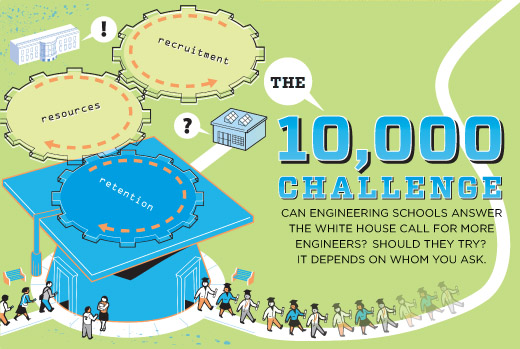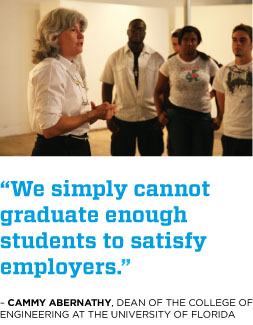The 10,000 Challenge
+ BY THOMAS K. GROSE
+ ILLUSTRATION BY STANFORD KAY
For years, U.S. industry has repeated the mantra “We need more engineers.” Now the White House is listening, with the President’s Council on Jobs and Competitiveness declaring a national goal of graduating 10,000 more engineers a year – a jump of 14 percent from the 72,300 engineering bachelor’s degrees awarded last year. To help the process along, companies have pledged to hire 7,000 more interns and the council has promised further, as yet unspecified, initiatives. But the Obama administration’s challenge has thrown into sharp relief several pressing problems in engineering education: declining state support for public institutions, necessitating tuition hikes; a stagnant graduation rate relative to other academic majors; and poor retention.
To the question, do engineering schools have the needed capacity, the answer from many deans is yes – but the trend is not universal. “That is a very doable goal,” says Feniosky Peña-Mora, engineering dean at Columbia University. Indeed, many are already doing so. Michigan Technological University plans to increase its graduation rate by around 15 percent by 2020. Cammy Abernathy, dean of the College of Engineering at the University of Florida, has seen enrollment there shoot up nearly 20 percent over the past five years to 5,500 and says, “We simply cannot graduate enough students to satisfy employers.” Iowa State University says it’s on track to increase graduate numbers by around 14 percent. A number of private engineering schools are also in growth mode. Yet Gary S. May, dean of the College of Engineering at Georgia Tech, says, “We are pretty close to full capacity,” and with no additional state funds in the pipeline, expansion isn’t in the cards.
Not everyone is convinced the White House goal is either possible to reach anytime soon or even desirable. C. Daniel Mote Jr., a mechanical engineering professor who was the longtime president of the University of Maryland, College Park, says that state schools will be hard-pressed to graduate that many additional engineers, especially given budget constraints. “There could be a real capacity problem,” he explains, with some schools forced to overcrowd their classrooms, rely too heavily on adjunct and temporary faculty, and schedule Saturday classes. Mote is not surprised that most engineering deans welcome the White House plan and are keen to expand their programs. But he claims the surge isn’t necessary. Currently, the nation has about 1.9 million engineers. American schools have over the decades typically graduated about as many engineers as industry needed, he says, and that’s still largely true, except in a few narrow areas — the petroleum and cybersecurity industries, for example. Increasing the supply of engineers won’t create more jobs, Mote says, and actually risks dampening demand and depressing salaries. “My heart says there should be more engineers, but I don’t see that demand at the moment.” He does not dispute that employers are snapping up recent graduates, but says that’s not proof of a supply shortage. The “young ones” are relatively cheap hires and have up-to-date skills. “Industry does not want to retrain employees,” he says. If he’s correct, the case for more engineers may lie less in the current state of the workforce – with the economy still in recovery – than in what National Academy of Engineering President Charles Vest anticipates will be a “wave of retirements in the coming years” as the baby boom generation ages.
The Impact of Tight Budgets
The burden of increasing capacity will fall largely on public universities. Why? Around 36 percent of the nation’s 641 institutions offering ABET-accredited engineering programs are private, but they account for slightly fewer than 20 percent of total graduates. “The bulk of America’s engineers are produced at public universities,” Abernathy says; that’s not going to change. And that exposes the complicated economics faced by public and land-grant universities. Budget-constrained state legislatures have been slashing higher-education funding. Leonard Bohmann, associate dean at Michigan Tech, estimates that most public schools now get less than 30 percent of revenues from states. Accordingly, tuition increases have become de rigueur at many schools. “We [public schools] are becoming increasingly like private universities. That is just the reality,” says Jonathan Wickert, Iowa State’s engineering dean. For some, this is an incentive to increase enrollment. “The more students we have, the more money we have,” Bohmann says. Iowa State’s budget system likewise rewards growth: The engineering school’s financial resources have expanded as its enrollment has increased. It is even adding 17 new faculty members this year.
In Iowa and some other states, the budget gods have tended to smile on engineering, relatively speaking. While Iowa State’s appropriations have nosedived 25 percent over the past three years, lawmakers found $74 million to fund a new engineering building complex. And though Michigan Tech also plans to add faculty in coming years, Bohmann argues that nationally additional teachers are not necessary to reach Obama’s goal. He estimates the current national B.S. degree/teacher ratio at around 2.75 percent; an additional 10,000 students could nudge it up to 3.1 percent, an average he calls “reasonable.”While their numbers won’t make a big dent in the national total, engineering deans at a number of private universities say they, too, are expanding operations. Since elite schools are reluctant to dilute their student bodies by adding many more students, this means drawing a bigger proportion to engineering. At Harvard, Dean Cherry Murray says her goal is to enroll 15 percent of the Harvard student body, which would more than double enrollment to around 1,000. Yale graduates around 70 engineers a year, and Dean T. Kyle Vanderlick says, “We could easily grow to 120 or 140, and it would still be an intimate setting.” Columbia graduates around 400 students a year, and Peña-Mora says it could boost that number by around 14 percent. At Princeton, engineering enrollment has climbed 20 percent in five years; this year’s freshman class numbers a record 330, outpacing overall student enrollment growth. Princeton’s undergraduate population, now 5,149, “grew by 10 percent over the last five years,” explains H. Vincent Poor, engineering dean. “It’s not going to grow again.”
Retention: ‘Low-Hanging Fruit’
Attracting – and keeping – a bigger proportion of incoming students requires a reversal of more than two decades’ graduation trends. The high-water mark in engineering education was 1985, when 77,572 undergraduate degrees were awarded, or 7.8 percent of the total number of bachelor’s degrees conferred that year. A lengthy decline followed. While the numbers have ticked upward in recent years, engineering’s share of the total number of degrees awarded has fallen to about 4 percent.
Deans at public and private schools agree that better retention would be the quickest, most economical way to increase graduate numbers. Georgia Tech’s Gary May calls it “low-hanging fruit.” A 2007 Science report found that the average retention rate at U.S. engineering schools was just 56 percent, and at some schools it was as low as 30 percent. Few students drop out because they can’t do the work, Florida’s Abernathy says. “They are just not enamored with the first-year courses.” So the notion is, fix that curricular defect, lose fewer students, and increase graduates. Some deans sound confident this will happen. “There is a revolution going on in engineering teaching,” Harvard’s Murray says, one that should eventually improve retention rates. “It’s one way to address the question of more [engineering graduates] without a huge amount of additional resources.” More schools are embracing active-learning techniques and entrepreneurship (see “Field of Dreams,”) and giving first- and second-year students hands-on projects that can include some engineering design to help keep them interested and staying put.
But tighter budgets can hamstring retention efforts. “We have not had the resources to scale up the successful pilot programs that we believe would have the biggest impact,” says Abernathy. For instance, Florida cut a pilot scheme that placed engineering teaching assistants into freshman chemistry courses to help students see how they would eventually use what they were learning. Moreover, the reality is that for several years now many schools have tried hard to improve retention rates with little to show for their efforts. Maryland’s Mote argues that reducing student attrition won’t increase graduation levels. Typically, public schools accept fairly large numbers of transfer students from community colleges to replace the freshmen and sophomores who drop out. If retention improves, there will be fewer places for transfer students, he says. “So, the overall numbers would not change much.”
Clearly, many engineering deans and educators believe that the administration’s goal is necessary and reachable. But Mote, for one, hopes that the effort evolves at a leisurely pace. He would prefer to see degree numbers increase by only a few percentage points at a time, to see if the market accepts the new additions. “If we are going to try to do this, I’d do it slowly, in increments.” Given austerity budgets and hard-to-change attrition levels, that may be the only way it’s going to happen.
Thomas K. Grose is Prism’s chief correspondent, based in London.
Previous Prism articles on this topic include: “Way to Grow,” April, 2010; “One in a Hundred,” January, 2010; and “Re-engineering Engineering,” February, 2009. Find them at www.prism-magazine.org.
Category: Features


